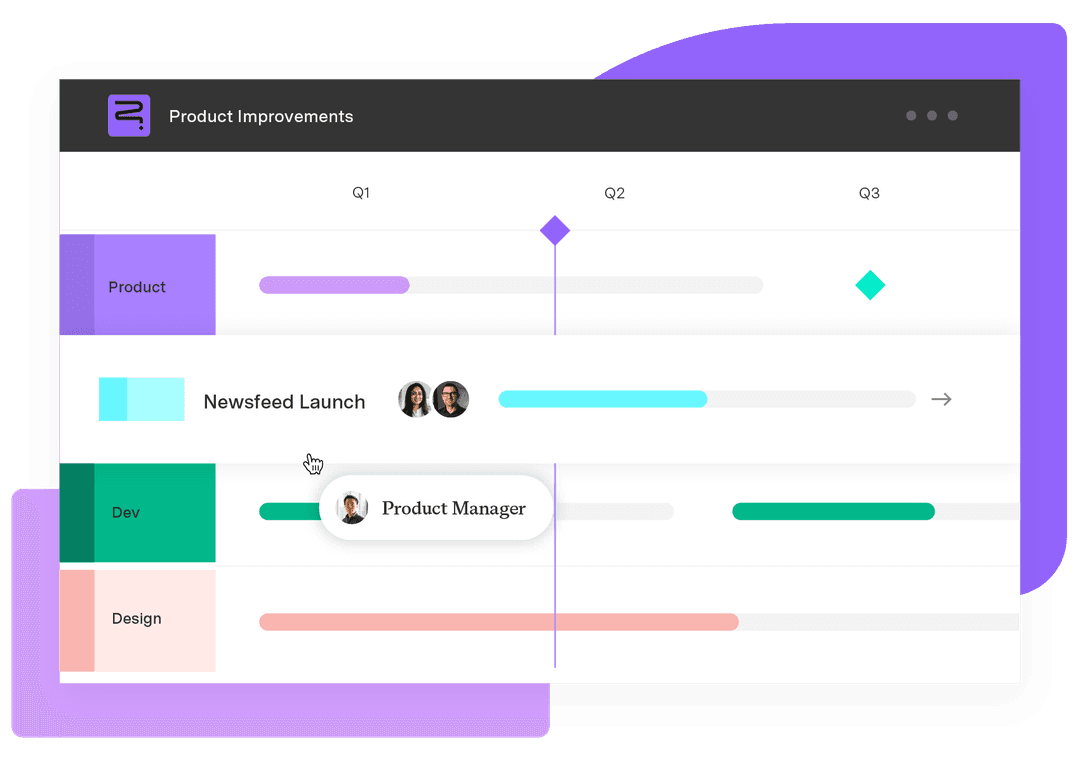Product owner vs. product manager: Roles and key differences
Tempo Team
Picture this: You’re in a sprint planning meeting, and someone asks, “Should we run this by the product owner or the product manager?”
Cue the awkward pause.
If you’ve ever Googled “product owner vs. product manager” mid-meeting, you’re not alone. The titles sound similar, and the lines between them can feel blurry in many teams. However, understanding the difference isn’t just a matter of semantics; it’s essential for clarity and collaboration, making sure the right work gets done at the right time.
Both jobs are crucial to building successful products, but they serve different purposes. Knowing who the project owner is and understanding each role’s responsibilities can help you align teams and deliver real value.
What is a product owner?
The product owner makes sure the team builds the necessary deliverables in the proper order at the right time. Their main job is to maximize the product’s value by aligning day-to-day work with customer and business needs. They manage and prioritize the product backlog, breaking big ideas into actionable user stories the Scrum team can deliver.
Unlike a product manager, who focuses on the broader product strategy, the product owner is immersed in day-to-day execution. They constantly collaborate with the Scrum team, answering questions, refining details, and adjusting plans as priorities shift (a common occurrence in agile product development).
A product owner is the tactical arm of the product team. While the product manager’s role emphasizes vision and direction, the product owner makes sure each sprint delivers working features to support that vision.
Here are a product owner’s primary responsibilities:
Own and maintain the product backlog
Translate features into prioritized user stories
Work closely with the Scrum team during sprints
Align development work with business needs and customer value
Clarify acceptance criteria and answer questions as they arise
Respond quickly to change – a must in agile frameworks
Support backlog refinement at scale in larger teams
What is a product manager?
While the product owner focuses on what the team is building, the product manager looks ahead – sometimes months, or even years, into the future. The product manager’s role is inherently strategic, guiding a product from conception to launch.
A product manager defines the product vision, conducts market research, and works closely with stakeholders to verify that the product solves real customer needs. They shape the product roadmap, set priorities based on impact and feasibility, and monitor the business objectives and metrics that matter most.
Unlike the Scrum product owner, who operates within an agile team, the product manager often works across departments to deliver a unified product experience. Their responsibilities vary depending on an organization’s structure and needs. Their day-to-day includes everything from reviewing user feedback to pitching features to executives. Senior product managers set company-wide priorities, whereas agile product managers support fast-moving teams. In every case, this role is about balancing big-picture thinking with real-world constraints.
A product manager’s duties include the following:
Define and communicate the product strategy and vision
Conduct market research and analyze trends
Collaborate with internal teams and stakeholders
Develop and maintain the product roadmap
Prioritize features based on customer impact and business goals
Track success metrics and adjust plans as needed
Align product development with company objectives
Act as the voice of the customer inside the organization
7 differences between a product manager and a product owner
The product owner vs. manager distinction centers on responsibility, focus, and impact. Both roles help build great products – especially within agile methodologies – but they emphasize different strengths. Here’s a deeper dive into how they differ:
1. Scope
The product manager maintains a big-picture view. They oversee the product’s journey from idea to market adoption, define the product strategy, confirm the product aligns with business goals, and plan for its future growth.
On the other hand, the product owner zooms in on the details. They’re responsible for the product backlog, working with the Scrum team to prioritize tasks and make sure each sprint delivers value. Product ownership involves deep involvement in the daily decisions that push the product toward the larger vision.
2. Strategic vs. tactical
The product manager is strategic. They focus on long-term goals, like defining the product vision, conducting market research, and deciding which features will drive the product forward. They set the product’s direction, steering it through different phases of its lifecycle.
In contrast, the product owner is tactical. They’re all about execution – breaking down the strategy into actionable user stories the development team can work on. They prioritize tasks, clarify questions from the team, and make sure every sprint contributes to overall goals.
3. Stakeholder interaction
The product manager interacts with a wide range of people, from stakeholders and executives to customers and marketing teams. They align the product with customer needs and business objectives, forming a bridge between the market’s needs and the company’s capabilities.
The product owner spends most of their time with the development team. They define acceptance criteria and adjust priorities as initiatives evolve. They keep the technical team on the same page, working toward relevant goals in the current sprint.
4. Decision-making
Both roles have decision-making authority – just in different areas. The product manager decides what the team should build and why, aligning features with customer needs, company OKRs, and market opportunities.
Meanwhile, the product owner considers technical constraints and team capacity to decide how those features should be implemented within the current sprint or iteration. This balance prevents bottlenecks and encourages agility while following the product roadmap.
5. Success metrics
Each role measures success using distinct metrics that relate to their responsibilities. Product managers are evaluated on long-term, high-impact indicators, such as:
User adoption
Retention rates
Revenue growth
NPS/customer satisfaction
Time-to-market alignment
Product owners are evaluated on execution-focused metrics, including:
Sprint velocity
Backlog health
Story completion rates
Delivery predictability
Developer satisfaction and flow
Both use product management tools and agile frameworks, but what they measure – and optimize for – varies significantly.
6. Daily responsibilities
If you could shadow both roles for a day, here’s what you might see.
Product managers:
Review customer feedback
Update the product roadmap
Collaborate with marketing and sales to align product positioning
Meet with executives to review progress and set future goals
Product owners:
Refine the backlog and write user stories
Answer questions from the Scrum team
Prioritize tasks and align the team
Review completed work and provide feedback
7. Internal vs. external focus
The product manager primarily examines external factors, like market research, user needs, competitor analysis, and positioning.
The product owner is more internally focused. They make sure the Scrum team has everything it needs to build the product efficiently, removing blockers so product development progresses smoothly.
Can a product owner also be a product manager?
Product owner and product manager roles are usually distinct in larger companies or more complex projects, with clear boundaries between them. However, these lines can blur in smaller companies or startups where people commonly take on multiple roles.
So, can one person handle both? In many cases, yes – especially in environments where speed and adaptability are essential. Here’s why one person might act as both the product owner and product manager:
Limited resources: Budget and headcount can pose a challenge in early-stage startups. With fewer team members, someone may need to handle both strategic and tactical duties to promote progress.
Speed over structure: Startups thrive on agility. Assigning one person to both roles means faster decision-making, fewer delays, and a more unified vision for the product. There’s no waiting for sign-offs between the product manager and product owner, as one person makes decisions from both angles.
Clearer communication: When a single person manages product strategy and execution, there’s less room for miscommunication. The product vision is more likely to be consistent across high-level goals and minute development details.
At the end of the day, wearing both hats requires agility and flexibility. It’s easier when you have the right tools to keep everything organized.
Supporting cross-functional product roles with Tempo
Although product owners and product managers have distinct responsibilities, their success relies on strong alignment and collaboration. Tempo bridges this gap with tools that support both roles while maintaining alignment.
Strategic Roadmaps helps product managers visualize the entire product strategy, from planning through execution. It allows them to prioritize tasks and manage the product’s long-term vision. For product owners, it divides these strategic goals into actionable user stories, ensuring every sprint delivers real value.
With Idea Manager, product owners and managers can capture, prioritize, and track ideas in one place. Product managers can integrate customer needs and market insights into the roadmap. Then, product owners can refine these ideas into actionable tasks for the development team.
Try Tempo today and see how it can help you manage product roles more effectively, delivering outstanding results for your team.











































